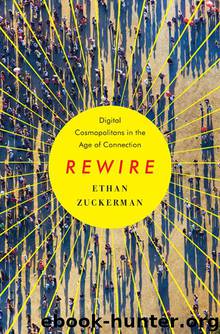Digital Cosmopolitans: Why We Think the Internet Connects Us, Why It Doesn't, and How to Rewire It by Ethan Zuckerman

Author:Ethan Zuckerman [Zuckerman, Ethan]
Language: eng
Format: epub
Published: 2014-06-05T04:00:00+00:00
TAKEN IN CONTEXT
THE EARLY 1980S WEREN’T ESPECIALLY KIND TO PAUL SIMON. He ushered in the second decade of his post–Simon & Garfunkel life with One Trick Pony, a forgettable companion album to a forgettable film starring his former musical partner, Art Garfunkel. When a 1981 reunion concert with Garfunkel brought 500,000 people to New York’s Central Park, and sold over two million albums in the United States, the two began touring together. But “creative differences” brought the arrangement to a premature end, and a planned Simon & Garfunkel album became a Simon solo release, Hearts and Bones, that was the lowest-charting of his career. With the breakup of his marriage to the actress Carrie Fisher, “I had a personal blow, a career setback and the combination of the two put me into a tailspin,” Simon told his biographer Marc Eliot.1
During this dark period, Simon was mentoring a young Norwegian songwriter, Heidi Berg. Berg gave Simon a cassette of mbaqanga music featuring musicians from Soweto, then the most notorious blacks-only township in apartheid South Africa. While the identity of the album Simon heard is uncertain,2 it likely featured the Boyoyo Boys, a popular Sowetan band, and listening to the cassette in his car, Simon began writing new melody lines and lyrics on top of the sax, guitar, bass, and drums of their existing tracks.
“What I was consciously frustrated with was the system of sitting and writing a song and then going into the studio and trying to make a record of that song. And if I couldn’t find the right musicians or I couldn’t find the right way of making those tracks, then I had a good song and a kind of mediocre record,” Simon told Billboard magazine’s Timothy White. “I set out to make really good tracks, and then I thought, ‘I have enough songwriting technique that I can reverse this process and write the song after the tracks are made.’”3
In the hopes of working this new way, Simon appealed to his record company, Warner Bros., to set up a recording session with the Boyoyo Boys. In 1985, that was far from an easy task. Since 1961, the British Musicians Union had maintained a cultural boycott of South Africa, managed by the UN Center against Apartheid. The boycott was designed to prevent musicians from performing at South African venues like Sun City, a hotel and casino located in the nominally independent bantustan of Bophuthatswana, an easy drive from Johannesburg and Pretoria. But the boycott covered all aspects of collaborations with South African musicians, and Simon was warned that he might face censure for working in South Africa.
When Simon turned to Warner Bros. for help, the company called Hilton Rosenthal. Then managing an independent record label in South Africa, Rosenthal had in the past worked with Johnny Clegg and Sipho Mchunu, the two musicians who became the heart of Juluku, a racially integrated band that electrified traditional Zulu music and brought it to a global audience. Rosenthal’s label had partnered with Warner Bros.
Download
This site does not store any files on its server. We only index and link to content provided by other sites. Please contact the content providers to delete copyright contents if any and email us, we'll remove relevant links or contents immediately.
| Anthropology | Archaeology |
| Philosophy | Politics & Government |
| Social Sciences | Sociology |
| Women's Studies |
Cecilia; Or, Memoirs of an Heiress — Volume 1 by Fanny Burney(32495)
Cecilia; Or, Memoirs of an Heiress — Volume 2 by Fanny Burney(31909)
Cecilia; Or, Memoirs of an Heiress — Volume 3 by Fanny Burney(31893)
The Great Music City by Andrea Baker(31758)
We're Going to Need More Wine by Gabrielle Union(19003)
All the Missing Girls by Megan Miranda(15779)
Pimp by Iceberg Slim(14434)
Bombshells: Glamour Girls of a Lifetime by Sullivan Steve(14022)
For the Love of Europe by Rick Steves(13597)
Talking to Strangers by Malcolm Gladwell(13291)
Norse Mythology by Gaiman Neil(13279)
Fifty Shades Freed by E L James(13187)
Mindhunter: Inside the FBI's Elite Serial Crime Unit by John E. Douglas & Mark Olshaker(9265)
Crazy Rich Asians by Kevin Kwan(9223)
The Lost Art of Listening by Michael P. Nichols(7453)
Enlightenment Now: The Case for Reason, Science, Humanism, and Progress by Steven Pinker(7273)
The Four Agreements by Don Miguel Ruiz(6701)
Bad Blood by John Carreyrou(6583)
Weapons of Math Destruction by Cathy O'Neil(6215)
